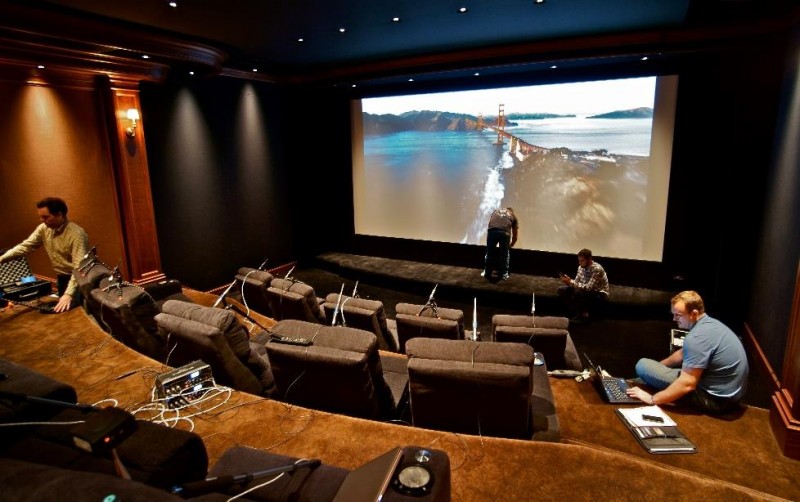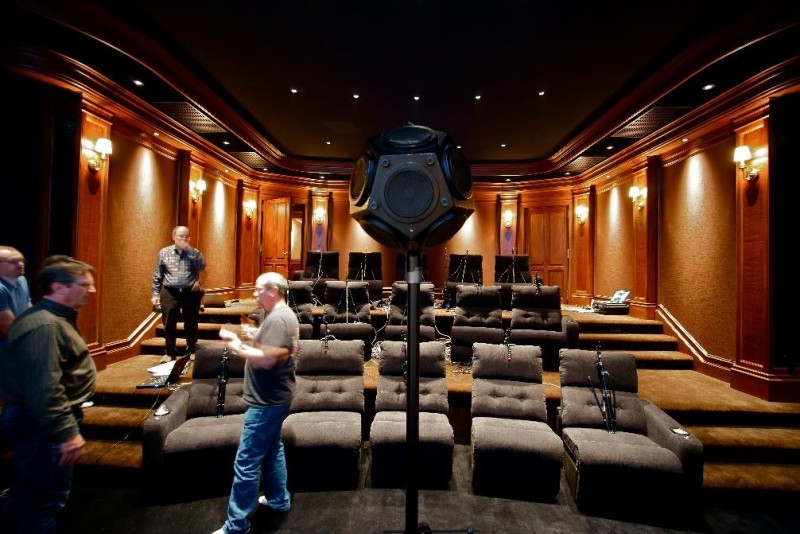"Cinema at the Edge"
I’m writing this from a hotel room in northern Italy, where Hanne and I have been getting some fresh mountain air and I’ve been thinking about the Black Label project we just finished for an accomplished cinematographer in New England.
The room’s lights-off design was guided by a simple mental image: An audience sitting at the rim of the Grand Canyon at night, with a screen magically suspended over it. The client, Rob, who’s not just a cinematographer but a born cine-phile, embraced the idea and became an integral part of the design team.
I based the lights-on design on classical mahogany columns arranged in a horseshoe layout reminiscent of European opera houses of the 18th and 19th centuries in general and Carnegie Hall in particular (where Rob regularly sang in his youth). Rich brown fabric panels bridge the roughly 55-inch span between columns, the last of which ends about 10 feet from the screen wall. That 10-foot space from the last column to the screen wall is expressed as a plane of jet black fabric, as are the screen wall and ceiling. The carpet at the front of the room is black as well. The only thing animating all that blackness is the image on the 19 ft-wide screen.
The Optics of You-Are-There
Basically, as you go from back to front in the room, your world – the warm tones and soft, embracing shape – peels away, leaving you perched on the edge of a chasm, an abyss, relieved only by the filmmaker’s creation playing out in the middle, a separate world vividly floating in what appears to be a formless, borderless void.
When the lights go down, there’s almost no trace of architecture or interior design within the audience’s field of view, nothing to pull them down to earth. It’s an important element in a larger program to get the audience into a You-Are-There state, and keep them there. (No matter how big the screen or loud the sound system, the more usual effect, even in elaborate home theaters full of expensive gear, is They-Are-Here.)


Most of our theaters have called for light control measures going back to the early ‘90s – large black borders around the video screen, shadow boxes, black carpeted stage, controlled-sheen wood finishes, aimable lighting with restricted beam patterns, and so on. Other designers have been experimenting with the same for decades.
In Rob’s theater we took our light management program to a new level of 3D computer modeling and renderings, as well as physical mock-ups. It turned out that the challenge wasn’t just finding a fabric with the right optical and acoustic qualities, nor the mechanics of stretching it on tension track, nor eliminating the ability of the technical devices behind it – speakers, subwoofers, and sound absorbers, diffusers, reflectors, traps etc. – to optically telegraph through it. In fact, the challenge wasn’t technical at all: It was to give that sea of black a shape that made it connect architecturally with the rest of the room during the lights-on experience.
Lights Off
Some weeks ago we shipped a pallet’s worth of test gear and made our way to Rob’s for testing & tuning. On Day 4 we moved the 20 mikes and cables out of the way, grabbed temped-in seats (the custom armrests hadn’t yet arrived), cued up the new 4k version of Lawrence of Arabia, switched the lights off and pressed Play. The effect was so powerful all six of us collectively gasped. We moved on to Gravity, which was so eerily balletic and deep that we found ourselves holding our breath. (It’s worth mentioning that we were watching the 2D version.)
Every movie created its own distinct sense of place and time; it almost seemed as if the uniqueness was not just visual and auditory, but tactile and olfactory as well.
Movie after movie, it’s the most intensely you-are-there cinematic venue known to me. My team and I aren’t the only ones. A month after we’d left Rob called with this report: “What you should know is that everyone I’ve had over comments that they remember the movie’s mood, lighting, and story weeks later. That’s new to me and everyone. You didn’t give Claudia and me a theater; you gave us a church: Every movie has been a religious experience.”
Back in Italy…
Today I stumbled upon a “cinema naturale” above our base in Merano (in what the German speaking population calls Süd-Tirol and Italian speakers call Alto Adige). Conceptually, the “Knottnkino” (“Rocks Cinema”) has the same core elements as the rim-of-the-Grand-Canyon vision that drove Rob’s project: chairs, edge, chasm, scene.

But unlike Rob’s theater or any other one we’ve worked on, Knottnkino has no need for projector or screen. The cinematic content is provided by the mountains, clouds, and changing light. You hike in, take a seat, and stare, transfixed. It’s a different show every hour, depending on weather and nature. Brilliant.
The Big Picture
Magic is the goal of all private theaters and screening rooms. Behind the quiet fabric and wood finishes, all of the successful ones must be deeply multidisciplinary, performance-driven facilities – complicated – and even small missteps can make “magic” elusive. But elusive doesn’t apply to Rob’s theater.
In fact, in Rob’s and a handful of other unforgettable ones, you leave with the feeling that the immersion you experienced wasn’t the result of disciplined engineering studies, CAD drawings, mock-ups and tests; it just “happened”. Entering other lives and places and stories is seamless and natural, like kicking off your shoes and snuggling your toes into your favorite slippers.
In these special places, these “churches” to use Rob’s term, it seems there are just a couple of simple things that create that You-Are-There magic. In his theater and Knottnkino, the “simple things” are an edge and a chasm.
-Keith
(Knottnkino is the work of an artist, Franz Messner, who had the idea, made the chairs and managed the installation back in 2000. If you happen to be near Merano, getting to Knottnkino is an hour’s round-trip hike. (Park at the Grüner Baum Inn in nearby Vöran and follow the signs.)

